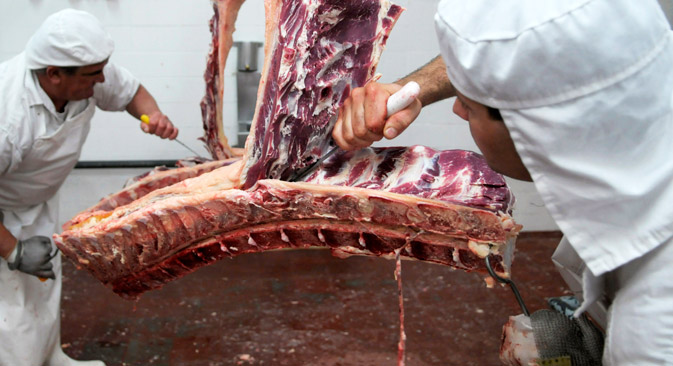
In 1985, the Soviet Union imported 936,000 tons of meat and meat products. Source: AP
The ban on British meat was the longest in the history of trade relations between Russia and the United Kingdom. It was introduced in 1986, due to a strain of spongiform encephalopathy ("mad cow disease") detected in British meat. The ban had already been imposed by Soviet officials, despite the incipient thawing of relations with the West and the threat of a shortage of meat in the market.
In 1985, the Soviet Union imported 936,000 tons of meat and meat products, or 7.6 percent of domestic demand from Great Britain, according to InvestCafe analyst Igor Arnautov. The embargo was canceled on Sept. 16, 2013, on the opening day of the Seventh International Forum World Food, which was held in Moscow.
Both sides could not come to mutual understanding, and the creation of the Customs Union between Russia, Kazakhstan and Belarus further delayed the compromise. In July 2013, the U.K. Veterinary Service introduced information about the start of appropriate controls on British slaughterhouses to Rosselkhoznadzor (the Russian supervisory authority over the quality of food import). After auditing and negotiating with major U.K. and Russian veterinary inspectors, Rosselkhoznadzor canceled the temporary restrictions on imports of beef and lamb by-products from the United Kingdom.
Such a long absence led to complete disregard for British meat as a brand in Russia. Now, there are only meat and poultry by-products, and only on a very microscopic scale. In 7 months of the year 2013, imports amounted to only 851 tons, with a total market volume of 10.4 million tons.
This is not the most opportune moment to open the gates for British beef. The last large-scale redistribution of the market occurred in the country only recently, when Russia imposed restrictions on meat from the United States, Canada and Mexico, in connection with ractopamine discovered in it (use of which is prohibited in the territory of the Customs Union).
The U.S. share (about 7 percent of imports of beef), supplying mainly ferret (high quality meat for restaurants), was immediately taken by Australia, and the rest was taken by Latin American producers, says Vasily Proshchenkov, executive director of the National Union of Meat Processors.
According to the industry’s portal, Meatinfo, Brazil is now the undisputed leader among the providers, with 52 percent of the total imports of beef (or 164,000 tons for the 7 months of 2013). Major suppliers are also Paraguay (25 percent, or 77,000 tons), Uruguay (7 percent, or 24,000 tons), Australia (4 percent, or 11,000 tons) and Ukraine (3 percent, or 9,000 tons) . For all other countries, there is only 8 percent remaining.
“I do not think that lifting the ban will be very noticeable, at least at first,” says Anna Evangeleeva, head of the portal’s information -analytical department.
The total of Russian quotas for imported beef is 570,000 tons, of which the majority (or 530,000 tons) are frozen products, and the rest are chilled products. Judging by the prices, the market is quite stable.
In early August 2013, the price of production of Category I beef was an average of 186.9 rubles per kilogram, which is only 1 percent higher than the figure in 2012 and significantly below the inflation level. Consumer prices are going down—minus 5.1 percent compared to the 2012 price (264 rubles per kilogram). “It will be difficult to increase the share of exports of high production costs specific to the U.K.," says Proshchenkov.
Investment expert Timothy Soltes has a different opinion. According to him, meat production from the U.K. is intended for a rather narrow range of consumers and will therefore find its niche in the Russian market.
Russia lifts 27-year ban on British meat subproducts
Russia’s imported meat ban spreads to Mexico, Canada
Russian consumer protection watchdog chief sees no reasons to ban EU meat imports
As for the by-products, Proshchenkov estimates that, in Russia, there is a continuing strong demand for beef liver, heart and tongue. Also in demand are natural membrane—beef’s caecum, lamb’s intestines. “Because of the temporary ban on imports of beef and related products from a number of countries, the prices have more than doubled,” says the expert.
The market for products is growing—up by 20 percent in 2013, to 140,000 tons. Thus, in contrast to the production of poultry and pork, Russian producers cannot yet start to increase the production of beef and offal.
In the State Agriculture Development Program for 2013-2020, particular attention is paid to the subprogram on beef cattle: The federal budget allocated 499.4 billion rubles ($15.4 billion) for its development. Last year, there was a slight increase in population, however, and, after a sharp rise in prices due to the cost of feed, it started to decline again. According Evangeleeva, in January-July 2013, there is fixed reduction of cattle in Russia again—down to 20.9 million heads as of August 1, 2013 (-1.9 percent).
As for lamb, the market for this meat is relatively small in Russia. The share of imports of offal of sheep and goats for 7 months of the year amounted to only 40.4 tons, said Evangeleeva. Most products are coming from New Zealand; small deliveries are recorded from Uruguay. Even though the imports of mutton and goat meat have grown by 38 percent compared to last year, they are still very small—only 6.5 tons in the same period.
All rights reserved by Rossiyskaya Gazeta.
Subscribe
to our newsletter!
Get the week's best stories straight to your inbox